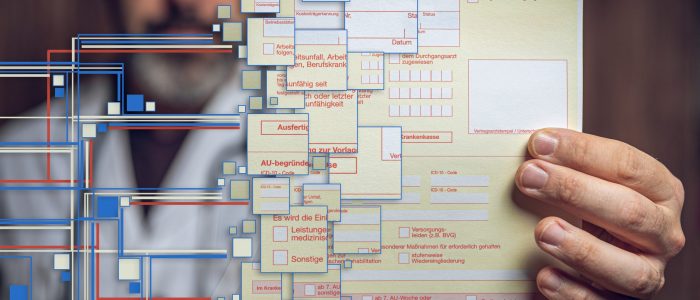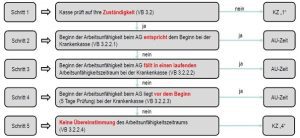The electronic certificate of incapacity for work (eAU) provides employers with a way to retrieve the certificate of incapacity for work digitally from the health insurance companies. This is also necessary, as the digital retrieval of certificates of incapacity for work will be mandatory from January 2023. The timecard offers you an interface so that you can access the digital AU directly.

The old and the new AU procedure
The entire procedure will be adapted as part of the AU changeover. Until now, the sickness absence certificate was a mass procedure. Every year, around 308 million forms are created as part of sickness absence certificates. This results in around 77 million certificates of incapacity for work.
The digital AU data has already been collected in the practice software of doctors’ surgeries for years. The data is also stored by the health insurance companies themselves. The aim is to ensure a complete inventory of all sickness absence certificates. In future, employers will have to retrieve the sickness absence certificates directly from a central server.
The classic “yellow slip” in paper form still exists, but is now only issued as personal proof for insured persons if this is necessary. Previously, paper forms were issued in multiple copies, resulting in a lot of paper waste. Health insurance companies, doctors and employers collected the forms, only to digitize them again separately. This is now being reduced to a single step.
In future, a phone call or e-mail to the employer will be sufficient to report sick. However, there will still be exceptions to this:
- The eAU only applies to employees with statutory health insurance. There is no comparable procedure for privately insured persons.
- Not every “incapacity for work” is reported via the eAU. Rehabilitation measures, private medical treatment for people with statutory health insurance and the determination of incapacity to work abroad are not included in the electrical AU.
In practice, the eAU will be available on the health insurance companies’ servers. However, it may not be directly available. The sick note must first be forwarded to the health insurance company by the doctor.
An unsuccessful eAU retrieval leads to a block on further retrievals. This is to prevent the server from being overloaded by too many simultaneous requests.
The advantages of the timecard AU
With the timeCard AU or the eAU procedure offers many advantages for employers, health insurance companies and employees.
The certificate of incapacity for work is sent digitally between the individual parties. This simplifies and speeds up the process for everyone involved. Employees in particular no longer have to do anything except go to the doctor. Once the sick note has been issued, everything continues without their involvement.
The creation and transmission costs are greatly reduced. The eAU is therefore not only safer and faster, but also more sustainable than the previous procedure.
Complete documentation with the health insurance companies is guaranteed. This ensures correct compensation for sickness benefit payments and in the pay-as-you-go procedure in accordance with the Expense Equalization Act.
The structure and process of the eAU in the timecard
The structure of the eAU within the timeCard-system works by extending the existing system. This requires at least the “timeCard 10” must be used. Older versions unfortunately do not support the eAU procedure.
It all starts with the licensing of the timeCard AU. This will give you the desired version and corresponding annual licenses.
You have the choice between different price models:
Basic versiontimeCard time recording-149,00 €
10 MA with annual license – 79,00 €
25 MA with annual license – 159,00 €
50 MA with annual license – 279,00 €
100 MA with annual license – € 499.00
250 MA with annual license – € 1,129.00
500 MA with annual license – € 1,999.00
Sick notes are easily created and can also be changed. The history of individual sick notes can be viewed at any time.
Sick note settings can be viewed at any time. For example, it is always possible to determine when a sick note must be submitted. However, the eAU procedure only provides for sickness notifications from employees themselves. This means that no distinction is made between “normally ill”, “ill without continued pay” or “accident at work”. All details go into the “Sick” absence account. An option such as “Child sick” is not provided for in the eAU procedure. In this case, the sick leave must still be entered manually.
The eAU web terminal provides access to the interface for administering the eAU and can initiate the reconciliation with the payroll accounting program directly.
The new audit-proof database for the eAU is strictly separated from the “normal” database.
dakota in timecard AU
The “dakota” data transfer program is used to communicate with the statutory health insurance association (GKV) and the health insurance fund (KK).
“dakota” stands for data exchange and communication based on technical systems.
This is a library that is used for the secure transfer of data between the timeCard-server and the health insurance companies’ IT infrastructure. All data is treated confidentially, sent unchanged and verified by the sender beforehand.
The certificate for the use of dakota is stored on the timeCard-customer.
Before data can be retrieved, the employment relationship must be compared with a payroll accounting program (EAP). To do this, for example, all the data required for reconciliation must be entered once a month in the timecard once a month. This works via an EAP import, which can be transmitted as a CSV file, for example. The procedure is similar to a master data import.
The data to be synchronized is as follows:
- Start of employment under social security law
- End of employment under social security law
- Birth name
- Place of birth
- Sex according to birth register / for registration procedures
- Social security number
- Company number of the health insurance company
- Type of health insurance
The data is acknowledged and checked on the communication servers in the GKV and KK computer centers. The data acceptance points then take care of the forwarding confirmations and error feedback.
The health insurance companies provide professional feedback.
The health insurance company’s professional feedback
The health insurance companies have a verification scheme for the eAU. This verification scheme looks like this:

The technical feedback relates to numerous individual aspects:
- Data record ID – a clear identification of data protection by the creator
- Cancellation indicator – an indicator for canceling a notification that has already been submitted
- Datensatz_ID_Ursprungsmeldung – the data record ID of the employer’s originally transmitted data record
- AU-ab_AG – the value in the AU-ab-AG field from the original notification
- AU-since – start of incapacity for work according to the AU notification
- Anticipated_AU_to – the date until which the AU is expected to apply
- Determined_on – Characteristics as specified by the doctor
- Current incapacity for work indicator – 1 means that the health insurance fund is not responsible; 4 means that there is no eAU or sickness notification
- Accident at work – “j” is entered here for an accident at work
- D_Doctor_assigned – if a doctor was assigned for an accident at work, consequences of an accident at work or occupational disease, a “j” is also added here
- Other_accident_consequences_of_accident – also enter a “j” for “yes” here
- Admission day – start of the inpatient stay
- Expected_duration_of_hospital_treatment – Date of the expected last day of the inpatient stay
Installing and setting up the timecard AU
The installation of the timeCard AU is carried out using the MSI Installer. Correct and complete registration data is required for this.
The following components are installed:
- eAU_TIMECARD database
- Service (Agent) eAU Agent
- Web server eAU_Manager
- ag (from ITSG)
As already mentioned, a certificate is required for dakota. Communication with health insurance companies always takes place via company numbers. For example, the company number communicates from the timeCard-customer communicates with the company number of the health insurance company. So it is always immediately clear who is in contact with whom.
To use dakota, an application must be made for a separate sender number. This is a sub-number to the actual company number.
This avoids conflicts with other systems that exchange data with the SHI’s information technology service center. These are, for example, EAP.
If several establishment numbers are called up, the form for the “self-declaration for a registration office” must also be completed.
The certificate is then applied for via the dakota user interface.
Confirmation that the certificate has been issued will be sent by e-mail. The certificate is valid for 3 years.
REINER SCT pays the license fees for dakota. However, dakota can only be installed for the timecard AU can be installed. If the license for the timeCard license is not renewed at some point, the associated certificate for dakota will be revoked.
The settings for the timecard AU can be accessed via individual buttons. There are settings for the company data, the master data (social security number and health insurance fund), manual changes to the personal data and the health insurance funds.
The legal basis of the eAU
The eAU will be legally binding from January 2023 and therefore comes with a number of legal regulations that employers, employees and health insurance companies must comply with:
Employer
- may not require employees with statutory health insurance to submit a certificate of sick leave
- must also call up the AU directly from the KK for temporary staff
- receive an indication of whether it is an accident or the consequences of an accident
- may also call up the times of hospital stays at KK
Employees
- must have an AU certificate issued as proof
- are not part of the eAU procedure as private patients
Health insurance companies
- must make sick leave data available to employers for retrieval; this also applies to temporary staff
- must report the start, end and expected duration of hospital stays
Conclusion
ThetimeCardAU relieves you of a lot of work and simplifies the handling of sickness absences in the company.